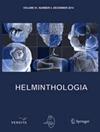毛滴虫虫卵的时间和空间模式:对巴基斯坦人类健康的潜在威胁
IF 1.2
4区 生物学
Q4 PARASITOLOGY
引用次数: 0
摘要
摘要 本研究调查了从巴基斯坦拉合尔城市地区采集的土壤样本中是否存在毛滴虫虫卵。在两年的时间里,从拉合尔城市地区共采集了 3600 份土壤样本。使用次氯酸钠(NaOCl)作为诊断技术对这些样本中的蠕虫卵进行了检测。研究显示,在拉合尔贫民窟地区受污染的土壤样本中,毛滴虫的总体流行率为 0.97%(3600 份样本中有 35 份)。按地理区域分析数据时,研究发现阿拉玛-伊克巴尔镇的毛滴虫感染率最高(1.83 %,600 人中有 11 人感染),其次是萨曼纳巴德(1.16 %,600 人中有 7 人感染)、瓦普达镇(1.00 %,600 人中有 6 人感染)、古尔贝格(1.00 %,600 人中有 6 人感染)和坎特(0.50 %,600 人中有 3 人感染)。相反,瓦伦西亚镇的患病率最低,为 0.33%(600 人中有 2 人)。不过,这些流行率的差异在统计学上并不显著(P = 0.117)。毛滴虫虫卵的流行率在不同采样季节有显著差异(p>0.001)。秋季共采集了 900 份土壤样本,其中有 19 份样本(2.11%)对毛滴虫检测呈阳性。与冬季、春季和夏季的感染率(分别为 0.66 %、0.22 % 和 0.88 %)相比,秋季的感染率明显较高。关于采样月份,研究发现 9 月份的流行率明显较高(3.33%,300 人中有 10 人),其次是 10 月份(2.33%,300 人中有 7 人)和 8 月份(1.33%,300 人中有 4 人)。其他月份的感染率逐渐下降,从 1 % 到 0.33 % 不等(300 人中有 3 到 1 人感染),3 月份没有检测到寄生虫(0 %,300 人中有 0 人感染)(p < 0.001)。这项研究强调了排泄物对土壤造成的污染,并凸显了在露天排便习惯的驱使下,公众对寄生虫生物学的不了解。本文章由计算机程序翻译,如有差异,请以英文原文为准。
Temporal and spatial patterns of Trichuris trichiura eggs: a potential threat to human health in Pakistan
Summary This study investigates the presence of Trichuris trichiura eggs in soil samples collected from urban areas in Lahore, Pakistan. A total of 3600 soil samples were collected over two years from Lahore’s urban regions. The detection of helminth eggs in these samples was performed using sodium hypochlorite (NaOCl) as a diagnostic technique. The study reveals an overall prevalence rate of T. trichiura at 0.97 % (35 out of 3600) in the contaminated soil samples from Lahore’s slum areas. When analyzing the data by geographical areas, the study found the highest prevalence of T. trichiura in Allama Iqbal Town (1.83 %, 11 out of 600), followed by Samanabad (1.16 %, 7 out of 600), Wapda Town (1.00 %, 6 out of 600), Gulberg (1.00 %, 6 out of 600), and Cantt (0.50 %, 3 out of 600). Conversely, Valencia Town had the lowest prevalence rate at 0.33 % (2 out of 600). However, these variations in prevalence rates were not statistically significant (p = 0.117). Prevalence rates of T. trichiura ’s eggs varied significantly across different sampling seasons (p>0.001). In autumn, a total of 900 soil samples were collected, with 19 samples (2.11 %) testing positive for T. trichiura . This rate was notably higher compared to the prevalence rates observed in winter, spring, and summer, which were 0.66 %, 0.22 %, and 0.88 %, respectively. Regarding the sampling months, the study observed a significantly higher prevalence during September (3.33 %, 10 out of 300), followed by October (2.33 %, 7 out of 300), and August (1.33 %, 4 out of 300). Prevalence rates gradually decreased in other months, ranging from 1 % to 0.33 % (3 to 1 out of 300), with no parasite detection in March (0 %, 0 out of 300) (p < 0.001). This research underscores soil contamination due to fecal waste and highlights public unawareness of parasite biology, driven by open defecation practices.
求助全文
通过发布文献求助,成功后即可免费获取论文全文。
去求助
来源期刊

Helminthologia
生物-动物学
CiteScore
1.80
自引率
0.00%
发文量
21
审稿时长
>12 weeks
期刊介绍:
Helminthologia (HELMIN), published continuously since 1959, is the only journal in Europe that encompasses the individual and collaborative efforts of scientists working on a different topics of human, veterinary and plant helminthology. The journal responsibility is to enrich the theoretical and practical knowledge in very specific areas and thus contribute to the advancements in human and veterinary medicine and agronomy. Taking the advantage of comprehensive and multidisciplinary approaches journal still maintains its original spirit and is principal source of fresh scientific information regarding helminths, endoparasites and plant parasites. Addressing the most up-to date topics journal gained rightful and exceptional place next to the other high-quality scientific journals publishing in its field.
 求助内容:
求助内容: 应助结果提醒方式:
应助结果提醒方式:


